
A | B | C | D | E | F | G | H | CH | I | J | K | L | M | N | O | P | Q | R | S | T | U | V | W | X | Y | Z | 0 | 1 | 2 | 3 | 4 | 5 | 6 | 7 | 8 | 9
Peter the Apostle | |
|---|---|
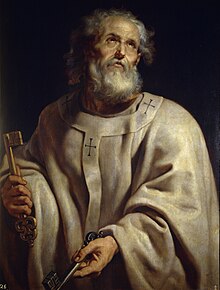 Saint Peter (c. 1610–1612) by Peter Paul Rubens, depicting Peter, vested in the pallium, and holding the Keys of Heaven | |
| Church | Early Christian |
| See |
|
| Papacy began | AD 30[1] |
| Papacy ended | Between AD 64 and 68[1] |
| Successor | |
| Orders | |
| Ordination | by Jesus Christ, AD 30 |
| Personal details | |
| Born | Shimoun Bar Younah (Imperial Aramaic: 𐡔𐡌𐡏𐡅𐡍 𐡁𐡓 𐡉𐡅𐡍𐡄) (Simeon, Simon) c. AD 1 |
| Died | Between AD 64 and 68 (aged 62–67) Vatican Hill, Rome, Italia, Roman Empire[3][4] |
| Parents | John (or Jonah; Jona) |
| Spouse | Yes, name unknown |
| Occupation | Fisherman, clergyman |
| Sainthood | |
| Feast day |
|
| Venerated in | All Christian denominations that venerate saints and in Islam |
| Canonized | Pre-Congregation |
| Attributes | Keys of Heaven, Red Martyr, pallium, papal vestments, man crucified upside down, vested as an Apostle, holding a book or scroll, Cross of Saint Peter |
| Patronage | Patronage list |
| Shrines | St. Peter's Basilica Church of St. Peter |
Saint Peter[note 1] (Imperial Aramaic: 𐡔𐡌𐡏𐡅𐡍 𐡁𐡓 𐡉𐡅𐡍𐡄, romanized: Shimoun Bar Younah; died AD 64–68),[1] also known as Peter the Apostle, Simon Peter, Simeon, Simon, or Cephas (Imperial Aramaic: 𐡊𐡉𐡐𐡀, romanized: Kipa, lit. 'Rock'),[6] was one of the Twelve Apostles of Jesus Christ and one of the first leaders of the early Christian Church. He appears repeatedly and prominently in all four New Testament gospels as well as the Acts of the Apostles. Catholic tradition accredits Peter as the first bishop of Rome—or pope—and also as the first bishop of Antioch.
According to Christian tradition, Peter was crucified in Rome under Emperor Nero. The ancient Christian churches all venerate Peter as a major saint and as the founder of the Church of Antioch and the Church of Rome,[1] but they differ in their attitudes regarding the authority of his successors. According to Catholic teaching, Jesus promised Peter a special position in the Church.[7] In the New Testament, the name "Simon Peter" is found 19 times. He is the brother of Saint Andrew, and they both were fishermen. The Gospel of Mark in particular was traditionally thought to show the influence of Peter's preaching and eyewitness memories. He is also mentioned, under either the name Peter or Cephas, in Paul's First Letter to the Corinthians and the Epistle to the Galatians. The New Testament also includes two general epistles, First Peter and Second Peter, that are traditionally attributed to him, but modern scholarship generally rejects the Petrine authorship of both.[8] Nevertheless, Evangelicals and Catholics have always affirmed Peter's authorship, and recently, evangelical scholars have revived the claim of Petrine authorship of these epistles.[9]
Based on contemporary historical data, Peter's papacy is estimated to have spanned from AD 30 to his death, which would make him the longest-reigning pope, at anywhere from 34 to 38 years; however, this has never been verified.[1]
Saint Irenaeus (c. 130 – c. 202 AD) explains the Apostle Peter, his See, and his successors in book III of Adversus Haereses (Against Heresies).[10] In the book, Irenaeus wrote that Peter and Paul founded and organised the Church in Rome.[11]
Sources suggest that at first, the terms episcopos and presbyteros were used interchangeably,[12] with the consensus among scholars being that by the turn of the 1st and 2nd centuries, local congregations were led by bishops and presbyters, whose duties of office overlapped or were indistinguishable from one another.[13] Protestant and secular historians generally agree that there was probably "no single 'monarchical' bishop in Rome before the middle of the 2nd century...and likely later."[14] Outside of the New Testament, several apocryphal books were later attributed to him, in particular the Acts of Peter, Gospel of Peter, Preaching of Peter, Apocalypse of Peter, and Judgment of Peter, although scholars believe these works to be pseudepigrapha.[15][16][17]
Names and etymologies

The New Testament presents Peter's original name as Simon (/ˈsaɪmən/ ⓘ; Σίμων, Simōn in Greek). In only two passages,[18] his name is instead spelled "Simeon" (Συμεών in Greek). The variation possibly reflects "the well-known custom among Jews at the time of giving the name of a famous patriarch or personage of the Hebrew Bible to a male child along with a similar sounding Greek/Roman name ".[19]
He was later given by Jesus the name Cephas (/ˈsiːfəs/[20]), from the Aramaic 𐡊𐡉𐡐𐡀, Kipa, 'rock/stone'. In translations of the Bible from the original Greek, his name is maintained as Cephas in nine occurrences in the New Testament,[21] whereas in the vast majority of mentions (156 occurrences in the New Testament) he is called Πέτρος, Petros, from the Greek and Latin word for a rock or stone (petra)[22] to which the masculine ending was added, rendered into English as Peter.[23]
The precise meaning of the Aramaic word is disputed, some saying that its usual meaning is "rock" or "crag", others saying that it means rather "stone" and, particularly in its application by Jesus to Simon, like a "jewel", but most scholars agree that as a proper name, it denotes a rough or tough character...[24] Both meanings, "stone" (jewel or hewn stone) and "rock", are indicated in dictionaries of Aramaic[25] and Syriac.[26]
Catholic theologian Rudolf Pesch argues that the Aramaic word would mean "precious stone" to designate a distinguishing person.[27][28] This cannot be sufficiently proven from Aramaic, however, since the use of the Aramaic root kp as a personal name has not been proven and there are hardly any known examples of the word being used to mean "precious stone".[29]
The combined name Σίμων Πέτρος (Símon Pétros, Simon Peter) appears 19 times in the New Testament. In some Syriac documents he is called, in English translation, Simon Cephas.[30]
Biographical information

Sources
The sources used to reconstruct the life of Peter can be divided in three groups:
- the New Testament writings, such as the Pauline Epistles (where Paul the Apostle calls him "Cephas" and "Peter"), the Petrine Epistles (traditionally attributed to him, but their authorship is disputed), the Canonical Gospels and the Acts of the Apostles;
- the New Testament apocrypha attributed to him, such as the Gospel of Peter, the Preaching of Peter, the Acts of Peter, the Acts of Peter and Andrew, the Acts of Peter and the Twelve, the Acts of Peter and Paul, the Letter of Peter to Philip, the Letter of Peter to James the Just, the Apocalypse of Peter and the Coptic Apocalypse of Peter. Scholars agree that these are late pseudepigrapha with little historical value, though they may contain some historical kernel;
- the writing of the Apostolic Fathers and the Church Fathers, such as Papias of Hierapolis, Pope Clement I, Polycarp, Ignatius of Antioch and Ireneus.
In the New Testament, he is among the first[note 2] of the disciples called during Jesus' ministry. Peter became the first listed apostle ordained by Jesus in the early Church.[35]
Accounts

Peter was a Jewish fisherman in Bethsaida (John 1:44).[37] He was named Simon, the son of a man named Jonah or John.[note 3] The three Synoptic Gospels recount how Peter's mother-in-law was healed by Jesus at their home in Capernaum (Matthew 8:14–17,[40] Mark 1:29–31,[41] Luke 4:38);[42] this passage clearly depicts Peter as being married or widowed. 1 Corinthians 9:5[43] has also been taken to imply that he was married.[44]

In the Synoptic Gospels, Peter (then Simon) was a fisherman along with his brother, Andrew, and the sons of Zebedee, James and John. The Gospel of John also depicts Peter fishing, even after the resurrection of Jesus, in the story of the Catch of 153 fish. In Matthew and Mark, Jesus called Simon and his brother Andrew to be "fishers of men" (Matthew 4:18–19,[45] Mark 1:16–17).[46]
In the Confession of Peter he proclaims Jesus to be the Christ (Jewish Messiah), as described in the three Synoptic Gospels: Matthew 16:13–20,[47] Mark 8:27–30[48] and Luke 9:18–21.[49] It is there, in the area of Caesarea Philippi, that he receives from Jesus the name Cephas (Aramaic Kepha), or Peter (Greek Petros).
In Luke, Simon Peter owns the boat that Jesus uses to preach to the multitudes who were pressing on him at the shore of Lake Gennesaret (Luke 5:3).[50] Jesus then amazes Simon and his companions James and John (Andrew is not mentioned) by telling them to lower their nets, whereupon they catch a huge number of fish. Immediately after this, they follow Him (Luke 5:4–11).[51] The Gospel of John gives a comparable account of "The First Disciples" (John 1:35–42).[52] In John, the readers are told that it was two disciples of John the Baptist (Andrew and an unnamed disciple) who heard John the Baptist announce Jesus as the "Lamb of God" and then followed Jesus. Andrew then went to his brother Simon, saying, "We have found the Messiah", and then brought Simon to Jesus, who immediately, at the first sight of him, named him as "Cephas". (John 1:42).[38]
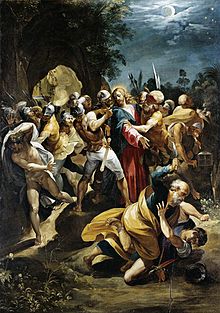
Three of the four gospels—Matthew, Mark and John—recount the story of Jesus walking on water. Matthew additionally describes Peter walking on water for a moment but beginning to sink when his faith wavers (Matthew 14:28–31).[53]
At the beginning of the Last Supper, Jesus washed His disciples' feet. Peter initially refused to let Jesus wash his feet, but when Jesus told him: "If I wash thee not, thou hast no part with me", Peter replied: "Lord, not my feet only, but also my hands and my head" (John 13:2–11).[54] The washing of feet is often repeated in the service of worship on Maundy Thursday by some Christian denominations.
The three Synoptic Gospels all mention that, when Jesus was arrested, one of his companions cut off the ear of a servant of the High Priest of Israel (Matthew 26:51,[55] Mark 14:47,[56] Luke 22:50).[57] The Gospel of John also includes this event and names Peter as the swordsman and Malchus as the victim (John 18:10).[58] Luke adds that Jesus touched the ear and miraculously healed it (Luke 22:49–51).[59] This healing of the servant's ear is the last of the 37 miracles attributed to Jesus in the Bible.
Simon Peter was twice arraigned, with John, before the Sanhedrin and directly defied them (Acts 4:7–22,[60] Acts 5:18–42).[61] Peter takes a missionary journey to Lydda, Joppa and Caesarea (Acts 9:32–Acts 10:2).[62] At Joppa, Peter had a vision given him from God which allowed for the eating of previously unclean animals, leading the early believers to the decision to evangelise the Gentiles (Acts 10).[63] Simon Peter applied the message of the vision on clean animals to the gentiles and follows his meeting with Cornelius the Centurion by claiming that "God shows no partiality".
According to the Acts of the Apostles, Peter and John were sent from Jerusalem to Samaria (Acts 8:14).[64] Peter/Cephas is mentioned briefly in the opening chapter of one of the Pauline epistles, Epistle to the Galatians, which mentions a trip by Paul the Apostle to Jerusalem where he meets Peter (Galatians 1:18).[65] Peter features again in Galatians, fourteen years later, when Paul (now with Barnabas and Titus) returned to Jerusalem (Galatians 2:7–9).[66] When Peter came to Antioch, Paul opposed Peter to his face "because he was in the wrong" (Galatians 2:11).[67][note 4]

Acts 12 narrates how Peter, who was in Jerusalem, was put into prison by Agrippa I (AD 42–44) but was rescued by an angel. After his liberation Peter left Jerusalem to go to "another place" (Acts 12:1–18).[68] Concerning Peter's subsequent activity there is no further connected information from the extant sources, although there are short notices of certain individual episodes of his later life.[1]
Peter's wife
Synoptic Gospels mention that Peter had a mother-in-law at the time he joined Jesus, and this mother-in-law was healed by Him.[69] However, the Gospels give no information about his wife. Clement of Alexandria claimed his wife was executed for her faith by the Roman authorities but does not specify any date or location.[70] Another opinion states that Peter's wife was no longer alive at the time he met Jesus, so he was a widower.[71]
First leader of the early Church
The Gospels and Acts portray Peter as the most prominent apostle, though he denied Jesus three times during the events of the crucifixion. According to the Christian tradition, Peter was the first disciple to whom Jesus appeared, balancing Peter's denial and restoring his position. Peter is regarded as the first leader of the early Church,[72][73] though he was soon eclipsed in this leadership by James the Just, "the brother of the Lord".[74][75] Because Peter was the first to whom Jesus appeared, the leadership of Peter forms the basis of the Apostolic succession and the institutional power of orthodoxy, as the heirs of Peter,[76] and he is described as "the rock" on which the church will be built.[72]
Position among the apostles

Peter is always listed first among the Twelve Apostles in the Gospels[77] and in the Book of Acts.[78] Along with James the Elder and John he formed an informal triumvirate within the Twelve Apostles. Jesus allowed them to be the only apostles present at three particular occasions during his public ministry, the Raising of Jairus' daughter,[79] Transfiguration of Jesus[80] and Agony in the Garden of Gethsemane.[81] Peter often confesses his faith in Jesus as the Messiah.
Peter is often depicted in the gospels as spokesman of all the Apostles.[82] John Vidmar, a Catholic scholar, writes: "Catholic scholars agree that Peter had an authority that superseded that of the other apostles. Peter is their spokesman at several events, he conducts the election of Matthias, his opinion in the debate over converting Gentiles was crucial, etc."[83]
The author of the Acts of the Apostles portrays Peter as the central figure within the early Christian community.[note 5]
Denial of Jesus by Peter
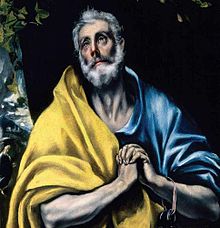
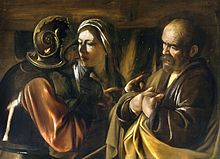
All four canonical gospels recount that, during the Last Supper, Jesus foretold that Peter would deny him three times before the following cockcrow ("before the cock crows twice" in Mark's account). The three Synoptics and John describe the three denials as follows:
- A denial when a female servant of the high priest spots Simon Peter, saying that he had been with Jesus. According to Mark (but not in all manuscripts), "the rooster crowed". Only Luke and John mention a fire by which Peter was warming himself among other people: according to Luke, Peter was "sitting"; according to John, he was "standing".
- A denial when Simon Peter had gone out to the gateway, away from the firelight, but the same servant girl (per Mark) or another servant girl (per Matthew) or a man (per Luke and also John, for whom, though, this is the third denial) told the bystanders he was a follower of Jesus. According to John, "the rooster crowed". The Gospel of John places the second denial while Peter was still warming himself at the fire and gives as the occasion of the third denial a claim by someone to have seen him in the garden of Gethsemane when Jesus was arrested.
- A denial came when Peter's Galilean accent was taken as proof that he was indeed a disciple of Jesus. According to Matthew, Mark and Luke, "the rooster crowed". Matthew adds that it was his accent that gave him away as coming from Galilee. Luke deviates slightly from this by stating that, rather than a crowd accusing Simon Peter, it was a third individual. John does not mention the Galilean accent.
In the Gospel of Luke is a record of Christ telling Peter: "Simon, Simon, behold, Satan hath desired to have you, that he may sift you as wheat: but I have prayed for thee, that thy faith fail not: and when thou art converted, strengthen thy brethren." In a reminiscent[89] scene in John's epilogue, Peter affirms three times that he loves Jesus.
Resurrection appearances
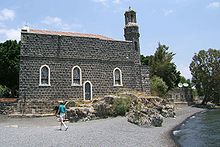
Paul's First Epistle to the Corinthians[90] contains a list of resurrection appearances of Jesus, the first of which is an appearance to Peter.[91] Here, Paul apparently follows an early tradition that Peter was the first to see the risen Christ,[35] which, however, did not seem to have survived to the time when the gospels were written.[92]
In John's gospel, Peter is the first person to enter the empty tomb, although the women and the beloved disciple see it before him.[93] In Luke's account, the women's report of the empty tomb is dismissed by the apostles, and Peter is the only one who goes to check for himself, running to the tomb. After seeing the graveclothes, he goes home, apparently without informing the other disciples.[94]
In the final chapter of the Gospel of John, Peter, in one of the resurrection appearances of Jesus, three times affirmed his love for Jesus, balancing his threefold denial, and Jesus reconfirmed Peter's position. The Church of the Primacy of St. Peter on the Sea of Galilee is seen as the traditional site where Jesus Christ appeared to his disciples after his resurrection and, according to Catholic tradition, established Peter's supreme jurisdiction over the Christian church.
Leader of the early Church

Peter was considered along with James the Just and John the Apostle as the three Pillars of the Church.[95] Legitimised by Jesus' appearance, Peter assumed leadership of the group of early followers, forming the Jerusalem ekklēsia mentioned by Paul.[72][73] He was soon eclipsed in this leadership by James the Just, "the Brother of the Lord."[74][75] According to Lüdemann, this was due to the discussions about the strictness of adherence to the Jewish Law, when the more conservative faction of James the Just[96] took the overhand over the more liberal position of Peter, who soon lost influence.[75][note 6] According to Methodist historian James D. G. Dunn, this was not a "usurpation of power", but a consequence of Peter's involvement in missionary activities.[98] The early Church historian Eusebius (c. AD 325) records Clement of Alexandria (c. AD 190) as saying:
For they say that Peter and James (the Greater) and John after the ascension of our Saviour, as if also preferred by our Lord, strove not after honor, but chose James the Just bishop of Jerusalem.[99]
Dunn proposes that Peter was a "bridge-man" between the opposing views of Paul and James the Just :
For Peter was probably in fact and effect the bridge-man (pontifex maximus!) who did more than any other to hold together the diversity of first-century Christianity. James the brother of Jesus and Paul, the two other most prominent leading figures in first-century Christianity, were too much identified with their respective "brands" of Christianity, at least in the eyes of Christians at the opposite ends of this particular spectrum.
— Dunn 2001, p. 577, Ch. 32
Paul affirms that Peter had the special charge of being apostle to the Jews, just as he, Paul, was apostle to the Gentiles. Some argue James the Just was bishop of Jerusalem whilst Peter was bishop of Rome and that this position at times gave James privilege in some (but not all) situations.
"Rock" dialogue
In a dialogue between Jesus and his disciples (Matthew 16:13–19), Jesus asks, "Who do people say that the Son of Man is?" The disciples give various answers. When he asks, "Who do you say that I am?", Simon Peter answers, "You are the Messiah, the Son of the living God." Jesus then declares:
Blessed are you, Simon son of Jonah, for this was not revealed to you by flesh and blood, but by my Father in heaven. And I tell you that you are Cephas (Peter) (Petros), and on this rock (petra) I will build my church, and the gates of Hades will not overcome it. I will give you the keys of the kingdom of heaven; whatever you bind on earth will be bound in heaven, and whatever you loose on earth will be loosed in heaven.
A common view of Peter is provided by Jesuit Father Daniel J. Harrington, who suggests that Peter was an unlikely symbol of stability. While he was one of the first disciples called and was the spokesman for the group, Peter is also the exemplar of "little faith". In Matthew 14, Peter will soon have Jesus say to him, "O you of little faith, why did you doubt?", and he will eventually deny Jesus three times. Thus, in light of the Easter event, Peter became an exemplar of the forgiven sinner.[100] Outside the Catholic Church, opinions vary as to the interpretation of this passage with respect to what authority and responsibility, if any, Jesus was giving to Peter.[101]
In the Eastern Orthodox Church this passage is interpreted as not implying a special prominence to the person of Peter, but to Peter's position as representative of the Apostles. The word used for "rock" (petra) grammatically refers to "a small detachment of the massive ledge",[102] not to a massive boulder. Thus, Orthodox Sacred Tradition understands Jesus' words as referring to the apostolic faith.
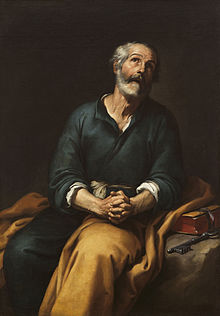
Petros had not previously been used as a name, but in the Greek-speaking world it became a popular Christian name, after the tradition of Peter's prominence in the early Christian church had been established.
Apostolic succession
The leadership of Peter forms the basis of the Apostolic succession and the institutional power of orthodoxy, as the heirs of Peter,[76] and is described as "the rock" on which the church will be built.[72] Catholics refer to him as chief of the Apostles,[103] as do the Eastern Orthodox[104] and the Oriental Orthodox.[105][106] In Coptic Orthodox Church liturgy, he is once referred to as "prominent" or "head" among the Apostles, a title shared with Paul in the text (The Fraction of Fast and Feast of the Apostles Peter and Paul in the Coptic Orthodox Church of Alexandria). Some, including the Orthodox Churches, believe this is not the same as saying that the other Apostles were under Peter's orders.
Antioch and Corinth
Antioch
According to the Epistle to the Galatians (2:11), Peter went to Antioch where Paul rebuked him for following the conservative line regarding the conversion of Gentiles, having meals separate from Gentiles.[note 7] Subsequent tradition held that Peter had been the first Patriarch of Antioch. According to the writings of Origen[108] and Eusebius in his Church History (III, 36) Peter had founded the church of Antioch.[109]
Later accounts expand on the brief biblical mention of his visit to Antioch. The Liber Pontificalis (9th century) mentions Peter as having served as bishop of Antioch for seven years, and having potentially left his family in the Greek city before his journey to Rome.[110] Claims of direct blood lineage from Simon Peter among the old population of Antioch existed in the 1st century and continue to exist today, notably by certain Semaan families of modern-day Syria and Lebanon. Historians have furnished other evidence of Peter's sojourn in Antioch.[note 8]
The Clementine literature, a group of related works written in the fourth century but believed to contain materials from earlier centuries, relates information about Peter that may come from earlier traditions. One is that Peter had a group of 12 to 16 followers, whom the Clementine writings name.[111] Another is that it provides an itinerary of Peter's route from Caesarea Maritima to Antioch, where he debated his adversary Simon Magus; during this journey he ordained Zacchaeus as the first bishop of Caesarea and Maro as the first bishop of Tripolis. Historian Fred Lapham suggests the route recorded in the Clementine writings may have been taken from an earlier document mentioned by Epiphanius of Salamis in his Panarion called "The Itinerary of Peter".[112]
Corinth
Peter may have visited Corinth, and maybe there existed a party of "Cephas".[35] First Corinthians suggests that perhaps Peter visited the city of Corinth, located in Greece, during their missions.[113]
Dionysius, bishop of Corinth, in his Epistle to the Roman Church under Pope Soter (A.D. 165–174), declares that Peter and Paul founded the Church of Rome and the Church of Corinth, and they have lived in Corinth for some time, and finally in Italy where they found death:
You have thus by such an admonition bound together the planting of Peter and of Paul at Rome and Corinth. For both of them planted and likewise taught us in our Corinth. And they taught together in like manner in Italy, and suffered martyrdom at the same time.[114]
Connection to Rome

Papacy
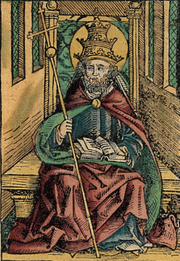
The Catholic Church speaks of the pope, the bishop of Rome, as the successor of Saint Peter. This is often interpreted to imply that Peter was the first Bishop of Rome. However, it is also said that the institution of the papacy is not dependent on the idea that Peter was Bishop of Rome or even on his ever having been in Rome.[115]
According to book III, chapter 3 of Against Heresies (180 AD) by Irenaeus of Lyons, Linus was named as Peter's successor and is recognised by the Catholic church as the second Bishop of Rome (pope), followed by Anacletus, Clement of Rome, Evaristus, Alexander, Sixtus, Telesphorus, Hyginus, Pius, Anicetus, Soter and Eleutherius.[116]
In his book Church History, Eusebius notes that Linus succeeded Peter as the bishop of the Church in Rome.[117]
As to the rest of his followers, Paul testifies that Crescens was sent to Gaul; but Linus, whom he mentions in the Second Epistle to Timothy as his companion at Rome, was Peter's successor in the episcopate of the church there, as has already been shown.
— Eusebius of Caesarea, Church History, Book III, Chapter 4
According to Tertullian's book Prescription against Heretics, it is stated that Clement was ordained by Peter as the bishop of Rome.[118]
...as also the church of Rome, which makes Clement to have been ordained in like manner by Peter.
— Tertullian, Prescription against Heretics, Chapter 32
St. Clement of Rome identifies Peter and Paul as the outstanding heroes of the faith.[35]
Coming to Rome
New Testament accountsedit
There is no obvious biblical evidence that Peter was ever in Rome, but the first epistle of Peter does mention that "The church that is at Babylon, elected together with you, saluteth you; and so doth Marcus my son."[119] It is not certain whether this refers to the actual Babylon or to Rome, for which Babylon was a common nickname at the time, or to the Jewish diaspora in general, as a recent theory has proposed.[120][121]
Paul's Epistle to the Romans, written about AD 57,[122] greets some fifty people in Rome by name,[123] but not Peter whom he knew. There is also no mention of Peter in Rome later during Paul's two-year stay there in Acts 28, about AD 60–62. With regards to the latter, Acts 28 does not specifically mention any of Paul's visitors.
Church Fathersedit
The writings of the 1st century Church Father Ignatius of Antioch (c. 35 – c. 107), whose authenticity is disputed,[124] refer to Peter and Paul giving admonitions to the Romans, indicating Peter's presence in Rome.[125]
Irenaeus of Lyons (c. 130 – c. 202) wrote in the 2nd century that Peter and Paul had been the founders of the Church in Rome and had appointed Linus as succeeding bishop.[126][127]
Clement of Alexandria (c. 150 – c. 215) states that "Peter had preached the Word publicly at Rome (A.D. 190)."[128]
According to Origen (184–253)[108] and Eusebius,[109] Peter "after having first founded the church at Antioch, went away to Rome preaching the Gospel, and he also, after presiding over the church in Antioch, presided over that of Rome until his death".[129] After presiding over the church in Antioch for a while, Peter would have been succeeded by Evodius[130] and thereafter by Ignatius, who was a disciple of John the Apostle.[131]
Lactantius, in his book called Of the Manner in Which the Persecutors Died, written around 318, noted that "and while Nero reigned, the Apostle Peter came to Rome, and, through the power of God committed unto him, wrought certain miracles, and, by turning many to the true religion, built up a faithful and stedfast temple unto the Lord."[132]
Simon Magusedit
Eusebius of Caesarea (260/265–339/340) relates that when Peter confronts Simon Magus at Judea (mentioned in Acts 8), Simon Magus flees to Rome, where the Romans began to regard him as a god. According to Eusebius, his luck did not last long, since God sent Peter to Rome, and Simon was quenched and immediately destroyed.[133]
According to Jerome (327–420): "Peter went to Rome in the second year of Claudius to overthrow Simon Magus, and held the sacerdotal chair there for twenty-five years until the last, that is the fourteenth, year of Nero."[134]
An apocryphal work, the Actus Vercellenses (7th century), a Latin text preserved in only one manuscript copy published widely in translation under the title Acts of Peter, sets Peter's confrontation with Simon Magus in Rome.[135][136]
Death and burialedit
Crucifixion at Romeedit

In the epilogue[137] of the Gospel of John, Jesus hints at the death by which Peter would glorify God, saying: "when you are old you will stretch out your hands, and another will dress you and carry you where you do not want to go."[138] This is interpreted by some as a reference to Peter's crucifixion.[89] Unitarian theologian Donald Fay Robinson has suggested that the incident in Acts 12:1–17,[139] where Peter is "released by an angel" and goes to "another place", really represents an idealised account of his death, which may have occurred in a Jerusalem prison as early as AD 44.[140]
Early Church tradition says that Peter died by crucifixion (with arms outstretched) at the time of the Great Fire of Rome in the year 64. This probably took place three months after the disastrous fire that destroyed Rome for which the emperor (Nero) wished to blame the Christians. This "dies imperii" (regnal day anniversary) was an important one, exactly ten years after Nero ascended to the throne, and it was "as usual" accompanied by much bloodshed. Traditionally, Roman authorities sentenced him to death by crucifixion at Vatican Hill.[1] In accordance with the apocryphal Acts of Peter, he was crucified head down.[141] Tradition also locates his burial place where the Basilica of Saint Peter was later built, directly beneath the Basilica's high altar.

Pope Clement I (d. 99), in his Letter to the Corinthians (Chapter 5), written c. 80–98, speaks of Peter's martyrdom in the following terms: "Let us take the noble examples of our own generation. Through jealousy and envy the greatest and most just pillars of the Church were persecuted, and came even unto death. …Peter, through unjust envy, endured not one or two but many labours, and at last, having delivered his testimony, departed unto the place of glory due to him."[142]
The apocryphal Acts of Peter (2nd cent.) (Vercelli Acts XXXV)[143] is the source for the tradition about the famous Latin phrase "Quo vadis, Domine?" (in Greek: Κύριε, ποῦ ὑπάγεις "Kyrie, pou hypageis?"), which means "Where are you going, Lord?". According to the story, Peter, fleeing Rome to avoid execution meets the risen Jesus. In the Latin translation, Peter asks Jesus, "Quo vadis?" He replies, "Romam eo iterum crucifigi" ("I am going to Rome to be crucified again"). Peter then gains the courage to continue his ministry and returns to the city, where he is martyred. This story is commemorated in an Annibale Carracci painting. The Church of Quo Vadis, near the Catacombs of Saint Callistus, contains a stone in which Jesus' footprints from this event are supposedly preserved, though this was apparently an ex-voto from a pilgrim, and indeed a copy of the original housed in the Basilica of St Sebastian.
The death of Peter is attested to by Tertullian (c. 155 – c. 240) at the end of the 2nd century in his Prescription Against Heretics, noting that Peter endured a passion like his Lord's: "How happy is that church . . . where Peter endured a passion like that of the Lord, where Paul was crowned in a death like John's".[144] The statement implies that Peter was killed like Jesus (by crucifixion) and Paul was killed like John (by beheading). It gives the impression that Peter also died in Rome since Paul also died there.[145] In his work Scorpiace 15, he also speaks of Peter's crucifixion: "The budding faith Nero first made bloody in Rome. There Peter was girded by another, since he was bound to the cross."[146]
Origen (184–253) in his Commentary on the Book of Genesis III, quoted by Eusebius of Caesaria in his Ecclesiastical History (III, 1), said: "Peter was crucified at Rome with his head downwards, as he himself had desired to suffer."[147] The Cross of St. Peter inverts the Latin cross based on this refusal, and on his claim of being unworthy to die the same way as his Saviour.[148]
Peter of Alexandria (d. 311), who was bishop of Alexandria and died around AD 311, wrote an epistle on Penance, in which he says: "Peter, the first of the apostles, having been often apprehended and thrown into prison, and treated with ignominy, was last of all crucified at Rome."[149]
Jerome (327–420) wrote that "at Nero's hands Peter received the crown of martyrdom being nailed to the cross with his head towards the ground and his feet raised on high, asserting that he was unworthy to be crucified in the same manner as his Lord."[134]
Burialedit
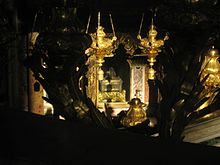
Catholic tradition holds that Peter's inverted crucifixion occurred in the gardens of Nero, with the burial in Saint Peter's tomb nearby.[150]
Caius in his Disputation Against Proclus (A.D. 198), preserved in part by Eusebius, relates this of the places in which the remains of the apostles Peter and Paul were deposited: "I can point out the trophies of the apostles. For if you are willing to go to the Vatican or to the Ostian Way, you will find the trophies of those who founded this Church."[151]
According to Jerome, in his work De Viris Illustribus (A.D. 392), "Peter was buried at Rome in the Vatican near the triumphal way where he is venerated by the whole world."[134]
In the early 4th century, the Emperor Constantine I decided to honour Peter with a large basilica.[152][153] Because the precise location of Peter's burial was so firmly fixed in the belief of the Christians of Rome, the church to house the basilica had to be erected on a site that was not convenient to construction. The slope of the Vatican Hill had to be excavated, even though the church could much more easily have been built on level ground only slightly to the south.[154] There were also moral and legal issues, such as demolishing a cemetery to make room for the building. The focal point of the Basilica, both in its original form and in its later complete reconstruction, is the altar located over what is said to be the point of Peter's burial.[155]

Relicsedit
According to a letter quoted by Bede, Pope Vitalian sent a cross containing filings said to be from Peter's chains to the queen of Oswy, Anglo-Saxon King of Northumbria in 665, as well as unspecified relics of the saint to the king.[156] The skull of Saint Peter is claimed to reside in the Archbasilica of Saint John Lateran since at least the ninth century, alongside the skull of Saint Paul.[157]
In 1950, human bones were found buried underneath the altar of St. Peter's Basilica. The bones have been claimed by many to have been those of Peter.[158] An attempt to contradict these claims was made in 1953 by the excavation of what some believe to be Saint Peter's tomb in Jerusalem.[159] However along with this supposed tomb in Jerusalem bearing his previous name Simon (but not Peter), tombs bearing the names of Jesus, Mary, James, John, and the rest of the apostles were also found at the same excavation—though all these names were very common among Jews at the time.
In the 1960s, items from the excavations beneath St Peter's Basilica were re-examined, and the bones of a male person were identified. A forensic examination found them to be a male of about 61 years of age from the 1st century. This caused Pope Paul VI in 1968 to announce them most likely to be the relics of Apostle Peter.[160] On 24 November 2013, Pope Francis presented part of the relics, consisting of bone fragments, for the first time in public during a Mass celebrated in St. Peter's Square.[161] On 2 July 2019, it was announced that Pope Francis had transferred nine of these bone fragments within a bronze reliquary to Orthodox Ecumenical Patriarch Bartholomew of Constantinople.[162] Bartholomew, who serves as head of the Eastern Orthodox Christian church, described the gesture as "brave and bold."[162] Pope Francis has said his decision was born "out of prayer" and intended as a sign of the ongoing work towards communion between the Orthodox and Catholic Churches.[163] The majority of Saint Peter's remains, however, are still preserved in Rome, under the high altar of St. Peter's Basilica.[164]
Scholarly viewsedit
Some church historians consider Peter and Paul to have been martyred under the reign of Nero,[165][166] around AD 65 after the Great Fire of Rome.[note 9][167][168] Currently, most Catholic scholars,[169] and many scholars in general,[170] hold the view that Peter was martyred in Rome under Nero.[note 10]
While accepting that Peter came to Rome and was martyred there, there is no historical evidence that he held episcopal office there.[172][173][174][175][176] According to two studies published by the German philologist Otto Zwierlein in 2009[177] and 2013 respectively,[178] "there is not a single piece of reliable literary evidence (and no archaeological evidence either) that Peter ever was in Rome."[120][179][note 11] Timothy Barnes has criticised Zwierlein's views as "a nadir in historical criticism".[184]
Clement of Rome's First Letter, a document that has been dated from the 90s to the 120s, is one of the earliest sources adduced in support of Peter's stay in Rome, but Zwierlein questions the text's authenticity and whether it has any knowledge about Peter's life beyond what is contained in the New Testament Acts of the Apostles.[120] The letter also does not mention any particular place, only saying: "Peter, through unrighteous envy, endured not one or two, but numerous labours and when he had at length suffered martyrdom, departed to the place of glory due to him" (ch. 5).[185]
A letter to the Romans attributed to Ignatius of Antioch might imply that Peter and Paul had special authority over the Roman church,[35] telling the Roman Christians: "I do not command you, as Peter and Paul did" (ch. 4), although Zwierlein says he could be simply referring to the Epistles of the Apostles, or their mission work in the city, not a special authority given or bestowed. Zwierlein questions the authenticity of this document and its traditional dating to c. 105–10, saying it may date from the final decades of the 2nd century instead of from the beginning.[120]
The ancient historian Josephus describes how Roman soldiers would amuse themselves by crucifying criminals in different positions,[186] and it is likely that this would have been known to the author of the Acts of Peter. The position attributed to Peter's crucifixion is thus plausible, either as having happened historically or as being an invention by the author of the Acts of Peter. Death, after crucifixion head down, is unlikely to be caused by suffocation, the usual "cause of death in ordinary crucifixion".[187]

Rome as Babylonedit
Church tradition ascribes the epistles First and Second Peter to the Apostle Peter, as does the text of Second Peter itself, an attribution rejected by scholarship. First Peter[119] says the author is in "Babylon", which has been held to be a coded reference to Rome.[188][189][190] Early Church tradition reports that Peter wrote from Rome. Eusebius of Caesarea states:
Clement of Alexandria in the sixth book of the Hypotyposeis cites the story, and the bishop of Hierapolis named Papias joins him in testifying that Peter mentions Mark in the first epistle, which they say he composed in Rome herself, and that he indicates this, calling the city more figuratively Babylon by these: "She who is in Babylon, chosen together with you, sends you greetings and so does my son Mark. (1 Pet 5:13)"[191]
If the reference is to Rome, it is the only biblical reference to Peter being there. Many scholars regard both First and Second Peter as not having been authored by him, partly because other parts of the Acts of the Apostles seem to describe Peter as an illiterate fisherman.[8][192]
Most Biblical scholars[193][194] believe that "Babylon" is a metaphor for the pagan Roman Empire at the time it persecuted Christians, before the Edict of Milan in 313: perhaps specifically referencing some aspect of Rome's rule (brutality, greed, paganism). Although some scholars recognise that Babylon is a metaphor for Rome, they also claim that Babylon represents more than the Roman city of the first century. According to Lutheran scholar on Revelation Craig R. Koester "the whore of Babylon is Rome, yet more than Rome".[195] It "is the Roman imperial world, which in turn represents the world alienated from God".[196]
At that time in history, the ancient city of Babylon was no longer of any importance. E.g., Strabo wrote, "The greater part of Babylon is so deserted that one would not hesitate to say ... the Great City is a great desert."[197]
Another theory is that "Babylon" refers to the Babylon in Egypt that was an important fortress city in Egypt, just north of today's Cairo and this, combined with the "greetings from Mark" (1 Peter 5:13), who may be Mark the Evangelist, regarded as the founder of the Church of Alexandria (Egypt), has led some scholars to regard the First Peter epistle as having been written in Egypt.[198]
Feast daysedit

The Roman Martyrology assigns 29 June as the feast day of both Peter and Paul, without thereby declaring that to be the day of their deaths. Augustine of Hippo says in his Sermon 295: "One day is assigned for the celebration of the martyrdom of the two apostles. But those two were one. Although their martyrdom occurred on different days, they were one."
This is also the feast of both Apostles in the calendar of the Eastern Orthodox Church.
In the Roman Rite, the feast of the Chair of Saint Peter is celebrated on 22 February, and the anniversary of the dedication of the two Papal Basilicas of Saint Peter's and Saint Paul outside the Walls is held on 18 November.
Before Pope John XXIII's revision in 1960, the Roman Calendar also included on 18 January another feast of the Chair of Saint Peter (denominated the Chair of Saint Peter in Rome, while the February feast was then called that of the Chair of Saint Peter at Antioch), and on 1 August the feast of Saint Peter in Chains.
Zdroj:https://en.wikipedia.org?pojem=Simon_Peter
Text je dostupný za podmienok Creative Commons Attribution/Share-Alike License 3.0 Unported; prípadne za ďalších podmienok. Podrobnejšie informácie nájdete na stránke Podmienky použitia.
Antropológia
Aplikované vedy
Bibliometria
Dejiny vedy
Encyklopédie
Filozofia vedy
Forenzné vedy
Humanitné vedy
Knižničná veda
Kryogenika
Kryptológia
Kulturológia
Literárna veda
Medzidisciplinárne oblasti
Metódy kvantitatívnej analýzy
Metavedy
Metodika
Text je dostupný za podmienok Creative
Commons Attribution/Share-Alike License 3.0 Unported; prípadne za ďalších
podmienok.
Podrobnejšie informácie nájdete na stránke Podmienky
použitia.
www.astronomia.sk | www.biologia.sk | www.botanika.sk | www.dejiny.sk | www.economy.sk | www.elektrotechnika.sk | www.estetika.sk | www.farmakologia.sk | www.filozofia.sk | Fyzika | www.futurologia.sk | www.genetika.sk | www.chemia.sk | www.lingvistika.sk | www.politologia.sk | www.psychologia.sk | www.sexuologia.sk | www.sociologia.sk | www.veda.sk I www.zoologia.sk
